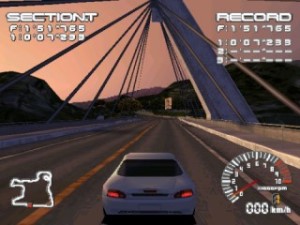
Granted there were a few that looked alright, and as per the laws of video game life as the consoles aged programmers got a better grip with the hardware and wringed bravura performances out of the circuitry. One such game happens to be my recent obsession: Ridge Racer Type 4. Released on these shores in September '99, by this time I had lost interest in video games even though, like nearly everyone else, we had a PlayStation too. So approaching a retro game without any familiarity or nostalgia is, I suppose, like normal gamers buying new, modern titles.
The original Ridge Racer was a coin-op conversion and launch title for the PlayStation and, as such, looks a bit ropey even by the system's standards. As Namco's cutting edge arcade game, and like every good launch title, it showed up not only what it could do better vis a vis its geriatric predecessors but also its potential. It was a reason-to-buy along with a killer clutch of early software that, sadly for Sega, its Saturn rival did not match. As such Ridge Racer established itself in the PlayStation canon, even if (whisper it) the game wasn't all that playability-wise. Two generally well thought-of sequels followed before Type 4 arrived on the scene.
I've already alluded to it, so I'll say it explicitly. For a PlayStation racing game, Type 4 is as gorgeous as it gets. Blockiness is reduced to a minimum, the so-called 'PlayStation shimmer' isn't that distracting, the cars and environments are well drawn. The colour scheme is especially praise-worthy. When you're bombing around the tracks the brilliant blues or downbeat hues of dusky digital skies is enough to make you think it's summer outside. We all know tunes can be summery, but games? The lighting effects on the cars and roads for night time driving give the game a stylish edge that retro gamers appreciate in Japanese-made titles. Seeing the fireworks explode as you race the final track on new year's eve '99 is indicative of the craft approach Japanese designers are known for. The soundtrack too is excellent. As a mix of drum and bass, ambient techno and proto-trance it conveys a hyper modern, if not futurist feel on proceedings.
As per its arcade roots, Type 4 is not a simulation. The accent is on playability, of flouting the laws of physics as you glide around corners at speeds in excess of 190kph. The responsiveness of the cars vary, but everything works as it should. And the artificial intelligence isn't bad either. I swear there have been too many times when computer-controlled opponents have blocked me from overtaking them, and by far the worst offender is your team mate!
Type 4 was after Sony's own Gran Turismo changed the terms of video game racing. It could not offer the depth of that title's career mode, and so replied in other ways. This, if you like, is the 'sociology bit'. At £40 a pop and with no trophies or achievements to shout about, responsible game designers had long been keen to maximise value for money, or last-ability. Secret levels or ratcheting up the game hours was one strategy, the other - common to racing games - was the pursuit of ephemeral experiences. Type 4 typifies this. The game comes with 'just' eight tracks and two single-player game modes, the 'Racing Roots Grand Prix 1999' and a race against the clock. There are also four racing teams with four car manufacturers (corresponding to difficulty levels). Racing each possible combination and qualifying for races in all the different qualifying positions unlocks cars for the time attack mode. There are 320 in total. Life's definitely too short. Yet there will be hundreds of thousands of gamers out there who spent countless hours either side of the millennium unlocking most or all of them. Yet think about the substance of the experience - the racing of slightly different designs around the same eight circuits with, in most cases, very slight variations in handling, speed and acceleration between them.
This hunt for ephemeral experience is integral to the ethics of gaming before the internet. Born of necessity, of the vast majority of console gamers not being able to buy a new game every week, mastery comes from playing something to death, of knowing absolutely every secret, every stratagem and sharpening up transferable gaming skills. Being able to kill Type 4, for instance, puts the player in a good position to display their skills if they have a gaming sesh on other racing games around a mate's house or, back then, in an arcade. From the publisher's point of view, building in such content was more than just good practice. Drawing the player into the hunt for ephemera primed the market for future titles in the franchise. The gamer knows that future iterations will carry over many of the features and game play they found so compelling. In Type 4's case, there have been eight titles for a variety of formats since.
As a retro experience, there are few PlayStation racers that have stood up as well as this. Give it a spin.
Phil,
ReplyDeleteMay I suggest you read a political dictionary before making of fool of yourself in future?
Think I'm getting the hang of dick-head sociology logic.
What a silly, silly man you are.
ReplyDeleteTo save yourself further embarrassment you are now banned. No need to thank me for doing you this service.
Interesting game!
ReplyDelete